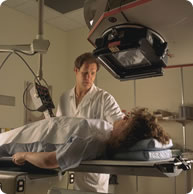Canadian History
Nuclear medical practices provide a reliable and non-intrusive way to diagnose and treat various diseases. Radioisotopes, such as cobalt, xenon, molybdenum and technetium, play an essential role in nuclear medicine. Their many applications include radioactive tracing that helps reveal how living organs function, nuclear magnetic resonance, which helps collect information about a body’s biochemistry, as well as palliative and curative cancer treatment. These techniques allow for early detection, diagnosis, monitoring and treatment of medical conditions and diseases.
 Canada is a world leader in the production and supply of radioisotopes for medical applications. About 15 to 20 million people, or roughly 67,000 per day, benefit from radioisotopes. Most of the world’s medical isotopes are produced in AECL’s National Research Universal NRU reactor at its Chalk River Laboratories (CRL).
Canada is a world leader in the production and supply of radioisotopes for medical applications. About 15 to 20 million people, or roughly 67,000 per day, benefit from radioisotopes. Most of the world’s medical isotopes are produced in AECL’s National Research Universal NRU reactor at its Chalk River Laboratories (CRL).
1950s
The cancer therapy technology that is currently standard practice throughout the world was pioneered in Canada. Canadian medical researcher, Dr. Harold Johns, developed the cobalt therapy machines that revolutionized the radiation treatment of cancer worldwide. Dr. Johns developed the machines in 1951 when he was at the University of Saskatchewan. That same year, Dr. Ivan Smith performed the world’s first Cobalt-60 cancer treatment at Victoria Hospital in London, Ontario, using Cobalt-60 produced in the NRU reactor. The London Regional Cancer Centre celebrated the 50th anniversary of the world’s first use of Cobalt therapy on October 27, 2001.
1960s
In 1964, AECL engineers were the first to develop commercial sterilizers used to process large volumes of medical, pharmaceutical, and food products. Since then Canada has installed more than 110 sterilization systems in 40 countries.
1970s
Human cell genetics research conducted at CRL in the 1970s laid the foundation and significantly advanced medical research programs now pursued by scientists all over the world. The findings, first reported by Dr. H.C. Birnboim, now at the Ottawa Regional Cancer Clinic, have been cited nearly 10,000 times in research undertaken by other scientists.
Canada has made some impressive contributions to world health care. Canadian scientists continue to research nuclear medicine techniques and explore the vastly refined techniques of medical science.